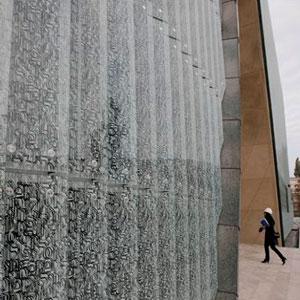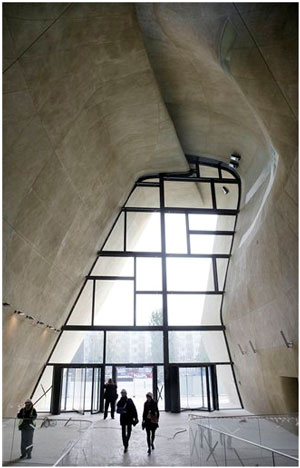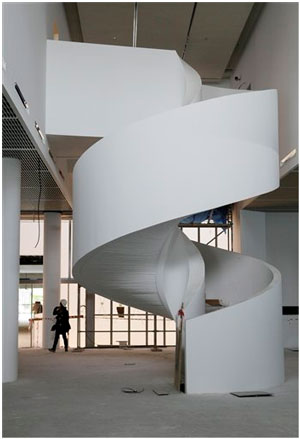
WARSAW, Poland (AP) — The box-like glass building rises from soil marked by tragedy in the heart of Warsaw's former Jewish district. At certain angles, its luminous facade reflects the outlines of a dark memorial to those who fought and died in the 1943 Warsaw Ghetto Uprising against the Nazis.
Yet despite reminders of Jewish suffering all around, the modern building will soon open as a key remembrance site of a mostly upbeat Jewish story, becoming home to the Museum of the History of Polish Jews, a major new museum dedicated to the 1,000 years of Jewish existence in Polish lands.
"It is a museum of life," said Sigmund Rolat, a Polish-born Holocaust survivor and American benefactor who has helped bring the museum to life. "We are showing 1,000 years of a magnificent history."
Construction of the building is nearly finished and the museum is scheduled to open in 2013 after nearly 20 years of planning. It will be a celebratory moment for those who have struggled to build a home for this story, among them Polish-born Holocaust survivors with a deep affection for their land of birth: Men like Rolat, 82, and Tad Taube, 81, a Krakow-born entrepreneur who leads two California-based philanthropies that have given $16 million to the project.
The museum fulfills a dream of Jews from around the world to preserve the rich legacy of their ancestors by creating what will be the first-ever museum of Polish Jewish history. Meanwhile, the Polish government, a major partner, also seeks to celebrate both the country's Jewish past and its own past eras of cultural tolerance and diversity. In doing so, the young democracy hopes to burnish its Western credentials and shed a reputation for anti-Semitism that has hung over it in recent decades.
Jewish history was largely ignored in the communist era, and the fact that the museum has risen with the help of the Polish government makes it a monument to a new consciousness and wealth.
 "No doubt it is thanks to democracy in Poland that this museum could be created," said Warsaw Mayor Hanna Gronkiewicz-Waltz.
"No doubt it is thanks to democracy in Poland that this museum could be created," said Warsaw Mayor Hanna Gronkiewicz-Waltz.
The project has faced a number of delays, some caused by the global financial crisis that for a time discouraged donations needed to complete the more than $100 million project. A public-private initiative that relies heavily on private funding, the museum has also struggled at times to persuade Jews abroad to help a project "in a country which they feel has not been particularly friendly to Jews," Taube said.
"This was not a slam dunk," Taube said. "But it got easier as the project rose from the ground. Doubts began to be erased."
Museum officials say it will open in stages, with educational and cultural programs starting in April to mark the 70th anniversary of the doomed Warsaw Ghetto Uprising. Then in December the heart of the museum is scheduled to open: a core exhibition of eight interactive multimedia galleries organized chronologically. Using diaries, memoirs, film footage and other original sources, the story will unfold in the voices of those living in the historical moment.
With its opening, the museum is expected to join the ranks of world-class Jewish history museums like Yad Vashem in Jerusalem and the United States Holocaust Memorial Museum in Washington.
What will set it apart will be its focus not on tragedy, but on creation, achievement and life. In keeping with that theme, the Warsaw museum will devote just one of the eight galleries to the Holocaust. Visitors, in fact, will not be able to access the Holocaust gallery without passing first through at least one other gallery, a reminder of the life that came long before and which still exists today in Poland's small but growing Jewish community.
The museum will show that the Holocaust — carried out by Adolf Hitler's Germany — was never the inevitable result of relations between Poland's Jews and Christians, despite periods of conflict. Still, museum creators say they will not shy away from showing ugly episodes of Polish anti-Semitism that led to economic boycotts, persecution and even massacres in the 19th and 20th centuries.
The complex message can be expected to challenge stereotypes held by some Poles and some Jews.
Poles, many of whom view their nation exclusively as a land of heroism that resisted the Nazi occupation, have reacted with defensive outrage in past years when acts of anti-Semitic violence during and after the war came to light. It's easy to imagine new controversies erupting when the museum opens and the Polish public is again confronted with oppression of Jews.
 Meanwhile, many Jews across the world carry an image of Poland that ignores some nuances. Some view Poland exclusively as a land of suffering for their people, and remembrance trips to Poland tend to consist mostly of visits to Auschwitz, Treblinka, the Warsaw Ghetto memorial and other memorials to tragedy. In many cases their forefathers left Poland in the worst possible moments, with memories of suffering lingering in families. They will be asked to see that Poland, over 1,000 years of history, was for long eras a land that welcomed Jews and where they thrived.
Meanwhile, many Jews across the world carry an image of Poland that ignores some nuances. Some view Poland exclusively as a land of suffering for their people, and remembrance trips to Poland tend to consist mostly of visits to Auschwitz, Treblinka, the Warsaw Ghetto memorial and other memorials to tragedy. In many cases their forefathers left Poland in the worst possible moments, with memories of suffering lingering in families. They will be asked to see that Poland, over 1,000 years of history, was for long eras a land that welcomed Jews and where they thrived.
"You don't live in a place for a thousand years and create a great civilization if it's one unmitigated disaster, which of course is one of the perceptions of the history of Polish Jews," said Barbara Kirshenblatt-Gimblett, the program director of the core exhibition. "It's a perception that was largely created by the cataclysmic events of the Holocaust. But we don't start with the Holocaust, and we don't end with the Holocaust."
There is much to commemorate. The uninterrupted existence of Jews in Poland over a millennium brought great achievements to Hebrew and Yiddish culture, to science and the arts. Polish Jews also contributed in significant ways to the larger Polish culture, with poets like Julian Tuwim still loved today, studied in schools, and remembered in streets names across Poland.
On the eve of World War II, the country was home to Europe's largest Jewish community, with 3.3 million people, or 10 percent of the entire Polish population. Most were killed in the Holocaust.
"This museum honors those who died by remembering how they lived — and how they lived for a thousand years," Kirshenblatt-Gimblett said.
The flourishing of Jewish culture and learning had an influence that reached far beyond Poland, and the museum will celebrate this legacy too. Israel's early leaders included Polish-born Jews like David Ben-Gurion and Menachem Begin. Poland was also the homeland of many who contributed to American and global culture: Albert Sabin, who developed a vaccine for polio; Isaac Bashevis Singer, the Nobel-winning writer whose books powerfully evoke the lost Yiddish world of his youth; Hollywood pioneers Harry Warner and Samuel Goldwyn; pianist Arthur Rubinstein and entrepreneurs like Max Factor and Helena Rubinstein.
The museum's central story of long life interrupted by tragedy is also carried in the striking architecture of the building, designed by Finnish architect Rainer Mahlamaki. On the outside, it is a square box of glass panels and perforated copper that emits a sea-green hue across a vast park-like square. Its lines are simple, sharp. On the inside, visitors enter a soaring hall with undulating sand-colored walls rising in curves. The chasm shape stands as a metaphor for both the parting of the Red Sea — a reference to the Jewish Biblical past — and the rupture in history created by the Holocaust.
To reach the core exhibition, visitors descend a staircase and enter an installation of sounds, light and graphics that evoke a poetic forest, a reference to the primeval forests of Poland that the first traveling Jewish merchants would have encountered 1,000 years ago. They will hear the word "Po-lin," which is the Hebrew word for "Poland" and also means "rest here," a reminder of how Poland became a land where Jews did indeed find rest after persecutions and expulsions from Spain and the German lands.
Visitors then leave the space of legend to enter a history that began in the 11th century, passing through periods that held both good and bad.
Copyright 2012 The Associated Press.
